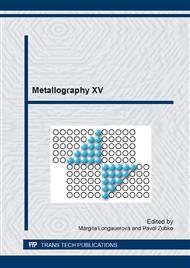p.186
p.191
p.197
p.201
p.205
p.209
p.215
p.221
p.227
Nanoindentation Measurements in Non-Oriented Silicon Steel at Elevated Temperatures
Abstract:
The present work deals about nanoindentation measurements between particular grains with various orientation at room and at elevated temperatures ( 100°C, 200°C, 250°C). Nanohardness measurements were carried out in non-oriented silicon steel with columnar microstructure, in order to evaluate local variation of work hardening as function of crystallographic orientation. The dependence of texture on the applied condition was studied by EBSD (Electron Backscatter Diffraction) analysis. Hardness was shown to decrease with increasing temperature in each of individual grains. The differences of hardness values were observed also between particular grain orientations.
Info:
Periodical:
Pages:
205-208
Citation:
Online since:
April 2014
Price:
Сopyright:
© 2014 Trans Tech Publications Ltd. All Rights Reserved
Share:
Citation:


